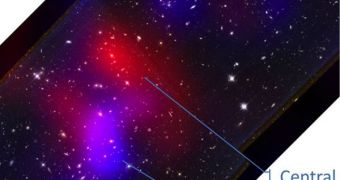By studying how two galaxy clusters merge, astrophysicists believe they may be able to get some deeper insights into the nature of dark matter. Such a collision is taking place about 5 billion light-years from us, and experts are dedicating all available resources to studying the phenomenon.
There are hundreds of galaxies in each of these clusters. Together, the interacting formation is called by the extremely-easy-to-remember name of DLSCL J0916.2+2951. Informally, it goes by the name of Perry's cluster, after its discoverer, Perry Gee, or the Musket Ball.
One of the reasons why investigators are monitoring this collision is the huge resemblance between a cluster and the entire Universe. According to University of California expert William Dawson, the former is a scaled-down version of the latter.
Therefore, by studying how it behaves, we may be able to draw some parallels between clusters and the entire Universe, which will come in very handy for explaining the nature of two of the greatest, most-well-hidden mysteries in the Cosmos – dark energy and dark matter.
The latter is the stuff that experts believe makes up about 23 percent of the Universe. About 72 percent is accounted for by dark energy, whereas all baryonic matter – the stuff out of which galaxies, stars and everything else is made – only accounts for 4.6 percent of the Cosmos.
“A galaxy cluster is like a little universe, because it has the same matter composition as the whole Universe, By studying this little universe, we can learn more about our own,” Dawson explains.
He adds that the Musket Ball is made up of only 2 percent baryonic matter, with 12 percent of its composition being accounted for by superheated gas, and roughly 86 percent by dark matter. When the two clusters interact, the most important part of their merger will take place between dark matter halos.
“Because these mergers separate the various matter components of the cluster, they provide astronomers with dissection of the cosmos that would otherwise be impossible,” the investigator adds.
The interacting clusters are being studied using the NASA/ESA Hubble Space Telescope, the Hawaii-based, 8-meter Subaru – the flagship telescope of the National Astronomical Observatory of Japan – the 10-meter Keck Telescope and the 4-meter Mayall Telescope, Daily Galaxy reports.

 14 DAY TRIAL //
14 DAY TRIAL //